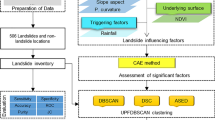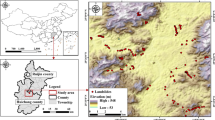Abstract
The aim of this study is to assess and compare two clustering algorithms, namely, the Wave-cluster and Density Based Spatial Clustering of Application with Noise (DBSCAN) algorithms, for landslide susceptibility assessment in Baota District, China. Based on historical reports, interpretation of aerial photographs and field survey reports, 293 were identified in the study area. Seven factors associated with landslide occurrence were prepared and used as inputs into the models for landslide susceptibility modelling. The models divided the study area grids into 478 and 465 subclasses, respectively, which were further grouped into five susceptibility levels using K-means algorithm, based on the landslide density values of the obtained subclasses. The resulting two models were validated and compared using area under the receiver operating characteristics (AUC-ROC) curve and statistical measures including sensitivity, specificity and accuracy. The analysis demonstrated that the Wave-cluster model outperformed the DBSCAN model with sensitivity, specificity and accuracy values of 88.05%, 89.2%, and 88.54%, respectively, while DBSCAN had sensitivity, specificity and accuracy values of 86.69%, 86.38%, and 86.56% respectively. In addition, the Wave-cluster model had higher value AUC of 0.823 than the DBSCAN model (0.808). This indicates that, the landslide susceptibility maps (LSMs) generated in this study had good performance for assessing landslide susceptibility in the study area and can be useful tools in assessing landslides, as the foundation for preventing and reducing landslide consequences for suitable social and economic development.











Similar content being viewed by others
References
Alimohammadlou Y, Najafi A, Gokceoglu C (2014) Estimation of rainfall-induced landslides using ANN and Fuzzy clustering methods: a case study in Saeen Slope, Azerbaijan province, Iran. CATENA 120:149–162
Ballabio C, Sterlacchini S (2012) Support vector machines for landslide susceptibility mapping: the Staffora River basin case study, Italy. Math Geosci 44:47–70
Caracciolo D, Arnone E, Conti L, Noto V (2017) Exploiting historical rainfall and landslide data in a spatial database for the derivation of critical rainfall thresholds. Environ Earth Sci 76:222
Chen XZ, Chen H, You Y (2016) Weights-of-evidence method based on GIS for assessing susceptibility to debris flows in Kangding County, Sichuan Province, China. Environ Earth Sci 75:70–88
Chen W, Shirzadi A, Shahabi H, Ahmad B, Zhang S, Hong H, Zhang N (2017) A novel hybrid artificial intelligence approach based on the rotation forest ensemble and naïve Bayes tree classifiers for a landslide susceptibility assessment in Langao County, China. Geomat Nat Hazards 8:1955–1977
Cruden DM (1991) A simple definition of a landslide. Bull Int Assoc Eng Geol 43:27–29
Dino B, David M, William E, Jim M, Taylor J, Erik S, Brian K (2015) A spectral clustering search algorithm for predicting shallow landslide size and location. J Geophys Res Earth Surf 120(2):300–324
Feizizadeh B, Roodposhti MS, Blaschke T, Aryal J (2017) Comparing GIS-based support vector machine kernel functions for landslide susceptibility mapping. Arab J Geosci 10:122
Frattini P, Crosta G, Carrara A (2010) Techniques for evaluating the performance of landslide susceptibility models. Eng Geol 111:62–72
Halkidi M, Batistakis Y, Vazirgiannis M (2001) Clustering validation techniques. J Intell Inf Syst 17:107–145
He Q, Shahabi H, Shirzadi A, Li S, Chen W, Wang N, Huiyuan C, Ma J, Chen Y, Wang X, Chapi K, Ahmad B (2019) Landslide spatial modeling using novel bivariate statistical based NaïveBayes, RBF Classifier, and RBF Network machine learning algorithms. Sci Total Environ 663:1–15
Hong H, Liu J, Tien D, Pradhan B, Acharya T, Phamh B, Zhu A, Chen W, Ahmad B (2018) Landslide susceptibility mapping using J48 Decision Tree with AdaBoost, Bagging and Rotation Forest ensembles in the Guangchang area (China). CATENA 163:399–413
Huang Y, Zhao L (2018) Review on landslide susceptibility mapping using support vector machines. CATENA 165:520–529
Mallat S (1989) A theory for multiresolution signal decomposition: the wavelet representation. IEEE Trans Pattern Anal Mach Intell 11:674–693
Mao Y, Zhang M (2015) Landslide hazards mapping using uncertain Naïve Bayesian classification method. J Cent South Univ 22:3512–3520
Mao Y, Zhang M, Sun P, Wang G (2017) Landslide susceptibility assessment using uncertain decision tree model in Loess areas. Environ Earth Sci 76:752–770
Melchiorre M, Matteucci A, Azzoni A, Zanchi A (2008) Artificial neural networks and cluster analysis in landslide susceptibility zonation. Geomorphology 94:379–400
Pham T, Bui T, Dholakia B, Prakash I, Pham V (2016) A comparative study of least square support vector machine and multiclass alternating decision trees for spatial prediction of rainfall-induced landslides in a tropical cyclones area. Geotech Geol Eng 34:1807–1824
Pham T, Prakash I, Bui T (2018) Spatial prediction of landslides using a hybrid machine learning approach based on random subspace and classification and regression trees. Geomorphology 303:256–270
Pokharel B, Omar FA, Ali A, Sang-Wan K, Samsung L, Hyuck-Jin P (2020) Spatial clustering and modelling for landslide susceptibility mapping in the north of the Kathmandu Valley, Nepal. Landslides 18:1403–1419. https://doi.org/10.1007/s10346-020-01558-5
Romeo S, Matteo D, Melelli L, Cencetti C, Dragoni W, Fredduzzi A (2017) Seismic-induced rock falls and landslide dam following the October 30, 2016 earthquake in Central Italy. Landslide 14:1457–1465
Roodposhti MS, Safarrad T, Shahabi H (2017) Drought sensitivity mapping using two one-class support vector machine algorithms. Atmos Res 193:73–82
Sheikholeslami G, Chatterjee S, Zhang A (2000) Wave-cluster: a multi-resolution clustering approach for very large spatial databases. VLDB J 8:289–304
Shi M, Chen J, Song Y et al (2016) Assessing debris flow susceptibility in Heshigten Banner, Inner Mongolia, China, using principal component analysis and an improved fuzzy C-means algorithm. Bull Eng Geol Env 75:909–922
Shirzadi A, Bui T, Pham T, Solaimani K, Chapi K, Kavian A, Shahabi H, Revhaug I (2017) Shallow landslide susceptibility assessment using a novel hybrid intelligence approach. Environ Earth Sci 76:60
Tang RX, Kulatilake PHSW, Yan EC, Jing SC (2020) Evaluating landslide susceptibility based on cluster analysis, probabilistic methods, and artificial neural networks. Bull Eng Geol Env 79:2235–2254
TsangaratosIlia PI (2016) Comparison of a logistic regression and Naïve Bayes classifier in Landslide susceptibility assessments: the influence of models’ complexity and training dataset size. CATENA 145:164–179
Wan S (2013) Entropy-based particle swarm optimization with clustering analysis on landslide susceptibility mapping. Environ Earth Sci 68:1349–1366
Wan S (2015) Construction of knowledge-based spatial decision support system for landslide mapping using fuzzy clustering and KPSO analysis. Arab J Geosci 8:1041–1055
Wang Q, Wang Y, Niu Q (2017) Integration of information theory, k-means cluster analysis and the logistic regression model for landslide susceptibility mapping in the three gorges area, China. Remote Sens 9:938
Wu H, Song T (2018) An evaluation of landslide susceptibility using probability statistic modeling and GIS’s spatial clustering analysis. Hum Ecol Risk Assess Int J 24(7):1952–1968
Xu C, Xu X (2012) Landslide hazard mapping using GIS and weight of evidence model in Qingshui river watershed of 2008 Wenchuan earthquake struck the region. J Earth Sci 23:97–120
Xu L, Dai FC, Tham LG, Zhou YF, Wu CX (2012) Investigating landslide-related cracks along the edge of two loess platforms in northwest China. Earth Surf Process Landf 37:1023–1033
Xu H, Ma C, Lian J, Xu K, Chaima E (2018) Urban flooding risk assessment based on an integrated k-means cluster algorithm and improved entropy weight method in the region of Haikou, China. J Hydrol 563:975–986
Yu D, Sheikholeslami G, Zhang A (2002) Finding outliers in very large datasets. Knowl Inf Syst 4:387–412
Yu C, Chen C, Lin L, Chen Y, Yu H (2006) Landslides and Rainfall characteristics analysis in Taipei City during the Typhoon Nari Event. Nat Hazards 37:153–167
Zhang S, Liu J (2010) Controlling factors of loess landslide in Western China. Environ Earth Sci 59:1671–1680
Zhang F, Kang C, Chan D, Zhang X, Pei X, Peng J (2017) A study of a flow-slide with significant entrainment in loess areas in China. Earth Surf Process Landf 42(14):2295–2305
Zhao Y, Li Y, Zhang L, Wang Q (2016) Ground water level prediction of landslide based on classification and regression tree. Geod Geodyn 5(7):348–355
Acknowledgements
This study was supported by the National Natural Science Foundation of China (41562019), the National Key Research and Development Projects of China (2018YFC1504705) and the National Natural Science Foundation of China (41530640, 41471001).
Author information
Authors and Affiliations
Corresponding author
Additional information
Publisher's Note
Springer Nature remains neutral with regard to jurisdictional claims in published maps and institutional affiliations.
Rights and permissions
About this article
Cite this article
Mao, Y., Mwakapesa, D.S., Xu, K. et al. Comparison of wave-cluster and DBSCAN algorithms for landslide susceptibility assessment. Environ Earth Sci 80, 734 (2021). https://doi.org/10.1007/s12665-021-09896-w
Received:
Accepted:
Published:
DOI: https://doi.org/10.1007/s12665-021-09896-w




